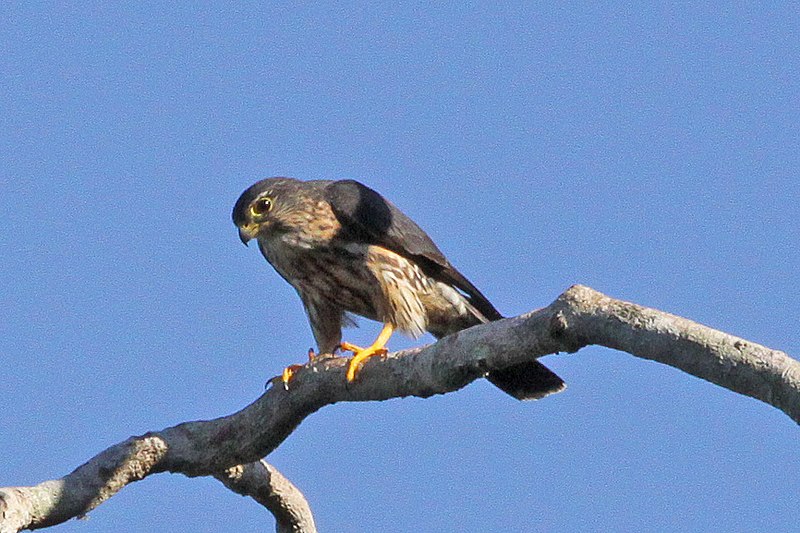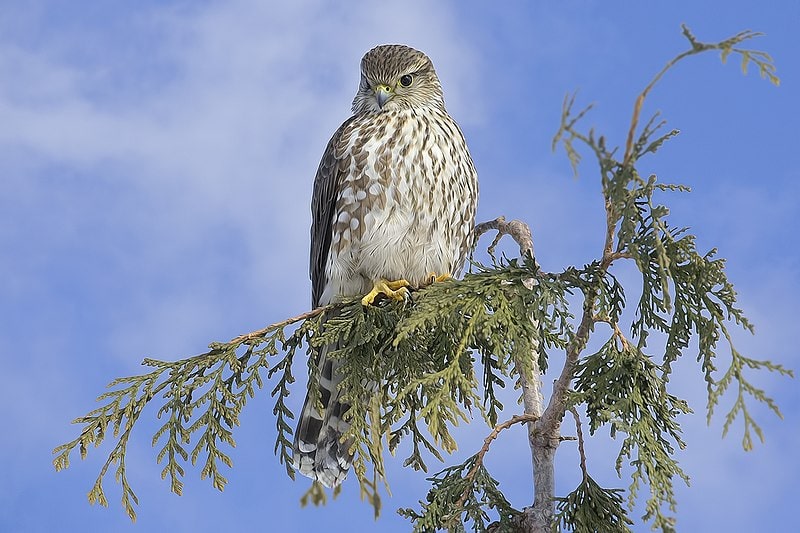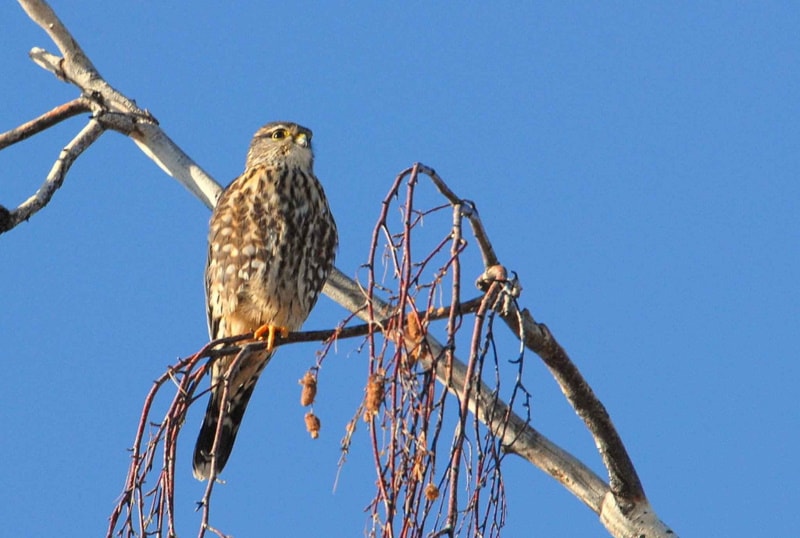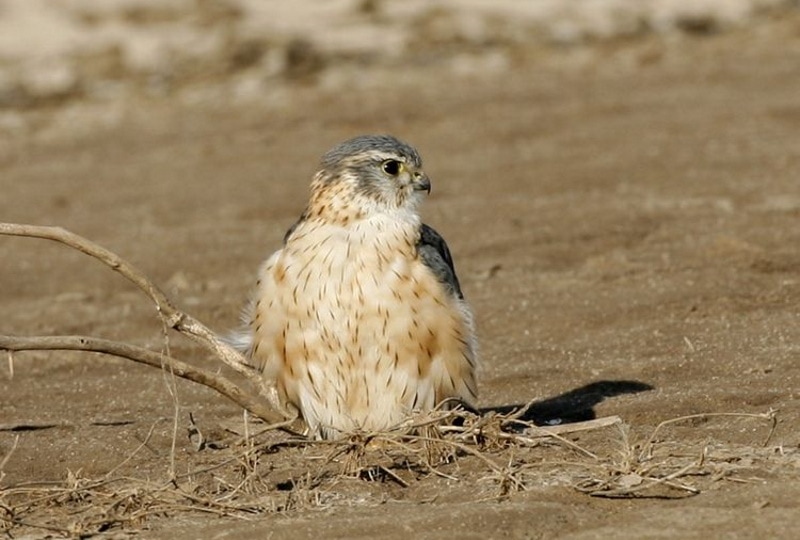Merlin Falcon: Field Guide, Pictures, Habitat & Info
Last Updated on

Also known as the smallest “bird of prey” and “pigeon hawks,” Merlin Falcons are aggressive birds flying high above the sky, looking to hunt smaller birds. They are widespread in the forests of North America and Eurasia.
In the early days, Merlin Falcons were famous as “lady hawks” among Medieval falconers. Not only that, but noblewomen also used these birds to take down Skylarks. That’s because Merlin Falcons are powerful fliers.
To spot these birds, you must visit the northern forests in North America and look for their nests with safety measures. Let’s explore everything about Merlin Falcons.

Quick Facts About Merlin Falcons
| Habitat | Forests |
| Diet | Birds |
| Behavior | Aerial forager |
| Nesting | Trees |
| Conservation | Low concern |
| Scientific name | Falco columbarius |
| Lifespan | 10 years |
Merlin Falcon: General Description
Merlin Falcons are a common bird species in North America and Eurasia, identified by their compact bodies compared to other larger falcons. They hunt small birds by surprise-attacking them from mid-air to satisfy their hunger.
Merlin Falcons are dark and steaky birds with distinctive streaks like most falcon species. Additionally, they are powerful fliers with exceptional hunting techniques.
You’re likely to find these birds in wild habitats, but they have changed their habitat since the 1960s. Merlin Falcons have become an urban bird species in multiple towns and cities. They nest on the northern prairies and stay there till migration. During this period, they hunt for House sparrows.

Merlin Falcon: Range, Habitat, Behavior, Diet & Nesting
Merlin Falcons are full of interesting facts. Let’s uncover them by understanding their range, habitat, behavior, diet, and nesting.
Range
Merlin Falcons are typically long-distance migrants, but some are resident birds. The dark-colored Merlins live in the Northwest all year or travel short distances south when it gets cold.
Many prairie Merlins migrate to the Southern and Central US and Northern Mexico. However, a few stay in urban areas all year. The taiga Merlins move to the coastal and southern US from northern breeding grounds and can travel far to Ecuador.
Habitat
Merlins prefer living in open and partially open areas in the Northern regions of North America. However, you may also find them nesting near forests, lakes, bogs, rivers, and lake islands. This is observed explicitly in boreal subspecies.
The Merlin Falcons from the Pacific Northwest typically nest in coastal areas alongside rivers. The prairie subspecies inhabit trees and shrubs near waterways. They may also nest in small thickets of deciduous trees.
Merlins have even inhabited towns and cities. In these places, these birds take over the nests of crows and raptors in conifers of residential areas, parks, cemeteries, and schoolyards.

Behavior
Merlin Falcons are strong fliers with an average speed of 30 miles an hour. They fly even faster when chasing and capturing their prey. Don’t let their small wings deceive you. These birds are even more powerful during flight as they can flap their wings quicker than Peregrine and Prairie falcons.
Merlin Falcons become quite aggressive during the breeding season. They protect their nests by chasing the predators away from their territory.
These birds are monogamous, but most look for new mates every year. Males show impressive flight displays when mating. It includes level flight with side-to-side rocking, slow fluttering in a circle, or U-like air dives.
Male Merlins also land slowly next to their partner while outstretching the legs and performing head bowing and tail fanning. They may also bring food for their mates.
Diet
The diet of Merlins primarily consists of birds. It also includes multiple small to medium birds ranging between 1–2 ounces. The most common ones are House Sparrow, Horned Lark, Least Sandpiper, Dickcissel, Dunlin, Bohemian Waxwing, and other song or shore birds.
The hunting technique of Merlin Falcons is quite different. Instead of stooping on birds like most falcons, they surprise attack their prey at high speeds horizontally and chase them upwards.
You may also see Merlin Falcons feasting on giant insects, including bats, dragonflies, and bats. The couple teams up to hunt big groups of prey. One attacks the flock from below, while the other starts capturing the prey.
Nesting
Since Merlins don’t create their nests, they opt for left-out crows, magpies, ravens, and hawks’ nests in conifers or deciduous trees. They may also nest in tree cavities, ground, or cliffs.

How to Find Merlin Falcons: Birdwatching Tips
Merlins are common during migration and winter, but it’s difficult to see them. That’s because they either sit on treetops to scan an area or fly at full speed, searching for small birds.
Also, Merlin Falcons fly very quickly, so you’d need to look for them immediately or they will fly away. Here are some birdwatching tips to help you out:
What to Listen For
Merlin Falcons give a chattering, shrill call for about 4 seconds when mating or defending their territory. They also make short, chirp-like sounds. Males have a higher-pitched voice than females.
What to Look For
Some identification signs for Merlin Falcons are:
- Size & Shape: These birds are small with a powerful build, making them look broader than American Kestrel. They are less bulky than Rock Pigeons, ranging between the size of a robin and a crow. They have pointed wings, a medium tail, and a broad chest. Their length is 9.4–11.8 inches with a weight of 5.6–8.5 ounces and a wingspan that is 20.9–26.8 inches long.
- Color: Merlins are dark and streaky. Males are gray, and females and chicks are brown. Their chest is streaked with dark underwings, and their tail with narrow, white-colored bands.

When to Look
The best time to look for Merlin Falcons is during winter and migration. Search for them in grasslands, open forests, and coastal areas at this time.
Attracting Merlin Falcons to Your Backyard: Tips & Tricks
Inviting Merlin Falcons to your backyard can be exciting but daunting. These birds can get aggressive, so make sure to do so safely. Here are a few tips to help you:
- Keep your yard well-maintained and decluttered to help the Merlin spot food quickly. You must also keep an eye on the grass level and ensure it isn’t long enough for other rodents to hide.
- Merlin birds need a place to roost. If your backyard has tall, sturdy trees, Merlins will sit on them and watch their prey and perch easily.
- Install bird baths to provide the birds with a reliable source of water. Merlins can quickly cool off in the summer and warm up in the winter.
- Make your yard balanced and welcoming to the birds. That means don’t play loud music, place noisy objects, or do anything that can scare Merlins and other birds away.
- Avoid using pesticides or chemical-containing fertilizers in your backyard. Doing so will ensure the safety of the birds.
- If you see a Merlin Falcon eating or hunting small birds, don’t shoo them away during their feast. Doing so will make the bird uncomfortable, and they may not return to your backyard again.

Merlin Falcon Conservation: Is this Bird Threatened?
The North American Breeding Bird Survey reported a 2% annual increase in Merlin populations from 1966 to 2019. This upsurge in their population was after the 1960s’ decline because of pesticide use.
Partners in Flight finds Merlin Falcon’s global breeding population around 3.2 million. This bird species also has a 7 out of 20 rating on the Continental Concern Score, making it a common concern.
Since the late 20th century, Merlins have been breeding in cities and towns where they consume House Sparrows and live in old crow nests.

Final Thoughts
Merlin Falcons are abundant bird species in North American forests. They reside in open and semi-open areas and lay eggs in already built nests of crows near lakes, rivers, and bogs. These birds are smaller than other falcons and feed on small birds.
Merlins have powerful wings, helping them fly at a very fast speed. Because of this, you may have difficulty spotting these birds if you’re a birdwatcher. But not all hopes are lost; listen carefully to their chirps and shrill calls to identify them!
Featured Image Credit: Merlin Falcon ( Image Credit: Ron Knight, Wikimedia Commons CC BY 2.0)
Table of Contents
About the Author Jeff Weishaupt
Jeff is a tech professional by day, writer, and amateur photographer by night. He's had the privilege of leading software teams for startups to the Fortune 100 over the past two decades. He currently works in the data privacy space. Jeff's amateur photography interests started in 2008 when he got his first DSLR camera, the Canon Rebel. Since then, he's taken tens of thousands of photos. His favorite handheld camera these days is his Google Pixel 6 XL. He loves taking photos of nature and his kids. In 2016, he bought his first drone, the Mavic Pro. Taking photos from the air is an amazing perspective, and he loves to take his drone while traveling.
Related Articles:
10 Types of Hummingbirds in Arkansas (With Pictures)
8 Types of Hummingbirds in Nebraska (With Pictures)
5 Types of Hummingbirds in Idaho (With Pictures)
3 Types of Hummingbirds in Mississippi (With Pictures)
8 Types of Hummingbirds in Kansas (With Pictures)
5 Types of Hummingbirds in West Virginia (With Pictures)
5 Types of Hummingbirds in Ohio (With Pictures)
Where Do Nuthatches Nest? Nuthatch Nesting Habits Explained
